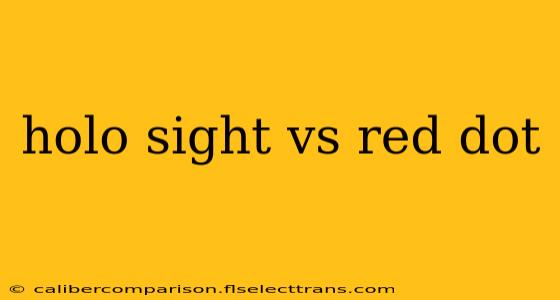Choosing between a holographic sight (holo sight) and a red dot sight can be tricky, as both offer similar benefits for aiming. However, understanding their key differences will help you select the optic that best suits your shooting style and intended use. This comprehensive guide breaks down the advantages and disadvantages of each, helping you make an informed decision.
Understanding the Core Differences: Holo Sight vs. Red Dot
Both holographic and red dot sights project a aiming point onto a lens, allowing for quick target acquisition. However, they achieve this in fundamentally different ways:
Holographic Sights (Holo Sights):
Holographic sights use a laser to project the reticle. This results in a brighter, clearer reticle image, especially in bright sunlight. The reticle is also typically larger and more robust, making it easier to find and acquire. Think of it like looking through a window with the reticle projected onto it.
Advantages of Holo Sights:
- Brighter Reticle: Exceptional brightness, even in challenging lighting conditions.
- Larger Reticle: Often features a larger reticle design, enhancing target acquisition speed, especially in stressful situations.
- Durable Construction: Generally more robust and resistant to impacts compared to red dots.
Disadvantages of Holo Sights:
- Higher Price Point: Typically more expensive than comparable red dot sights.
- Bulkier Design: Generally larger and heavier than red dot sights.
- More Power Consuming: Often requires more battery power.
Red Dot Sights:
Red dot sights use an LED (light emitting diode) to project the reticle. While generally less bright than holo sights, they offer a smaller, lighter design. The reticle appears to be superimposed onto the target.
Advantages of Red Dot Sights:
- Lower Price: Generally more affordable than holographic sights.
- Compact and Lightweight: Often smaller and lighter, making them ideal for carrying on smaller firearms or for extended use.
- Wider Variety: A significantly wider selection of models and features is available.
Disadvantages of Red Dot Sights:
- Less Bright Reticle: Can struggle in bright sunlight conditions, making the reticle difficult to see.
- Smaller Reticle: The smaller reticle can be more challenging to acquire quickly, especially for users with less experience.
- Potential for Parallax: Some red dot sights can experience parallax error, meaning the point of impact may shift slightly depending on the shooter's eye position.
Choosing the Right Sight: Application and User Considerations
The best choice depends heavily on your priorities and intended use. Consider the following:
For the Casual Shooter or Hunter:
A red dot sight is often a better choice. The lower price and lighter weight are appealing, and the performance is usually sufficient for recreational shooting.
For the Law Enforcement or Military Professional:
A holographic sight often offers the superior performance needed in high-stress situations. The brighter reticle and rugged construction are critical advantages.
For the Competitive Shooter:
The choice depends on the specific discipline. Both red dots and holo sights are used successfully in various competitive shooting sports, with the preference often coming down to personal preference and the specific demands of the competition.
Beyond the Basics: Features to Consider
Beyond the core differences, several other features influence the decision:
- Battery Life: Longer battery life is always a plus, especially for extended use.
- Reticle Options: Some sights offer multiple reticle choices, allowing customization.
- Durability: Look for a sight constructed from robust materials to withstand recoil and impacts.
- Waterproof and Fogproof: These features are crucial for shooting in various weather conditions.
Conclusion: Making the Right Choice
Ultimately, the "best" sight depends entirely on your individual needs and preferences. Carefully weigh the advantages and disadvantages of each type, considering your shooting style, budget, and intended use. Researching specific models within each category will further help you narrow down your options and select the perfect optic for your firearm.

